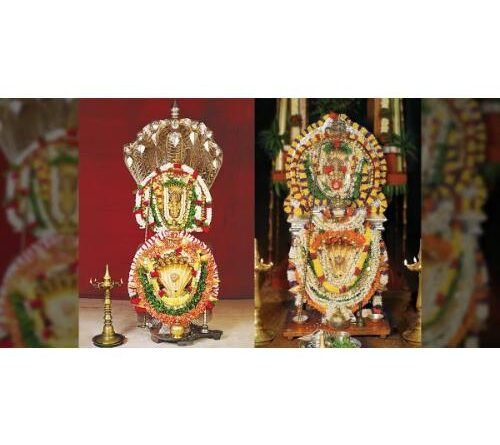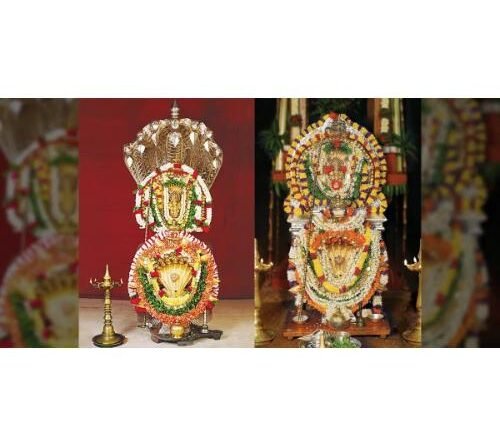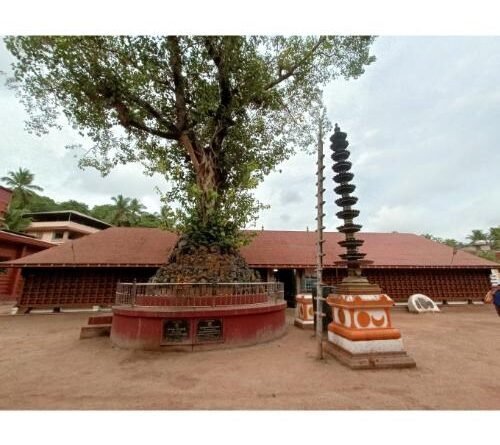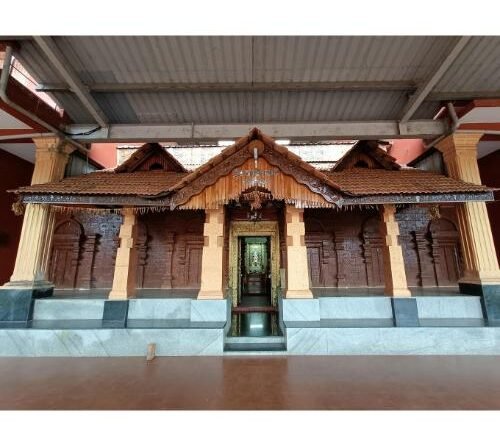Srimath Anantheshwara Temple Manjeshwar,Hosabettu,Kerala
MANJULAKSHETRA or MANJESHWARA is the name derived from the deity “SRI MANJARISHA” or Srimath Anantheshwara of the sacred Manjeshwar Temple. Considered as the most ancient existing temple of the Gowda Saraswat Brahmins, the known history of the Temple dates back to 8th century A.D. The Temple was last renovated in 1799 – 1804 A.D. after it was demolished by a nearly ruler. H.H Srimath Vibhudendra Tirtha Swamiji, the then Peetadhipathi of the Kashi Math Samsthan took the initiative in resurrecting the Temple and re-installing the presiding deity Shri Bhadra Narasimha.
MANJESHWAR or Manjulakshetra with its Puranic background is celebrated for its Temple dedicated to Srimad Anantheshwara, that is Shri Shiva accompanied by Shesha or Anantha. Evidently, the town derives its name from the presiding Deity Srimad Anantheshwar changed into “Madanantheshwar” and then into Manjeshwar by efflux of time and long usage. The image of Lord Shiva is believed to be an “Udbhava” or “Swayambhoo” (Self emergent). Besides the image of Shiva, there are in the temple images of Lord Narasimha and Subramanya, the latter Deity rarely worshipped in South Canara. Originally in the Madras State but now in Kerala, Manjeshwar is situated 17 Kilometers south of Mangalore on the Cochin – Mangalore section of the Southern Railway, the Temple is about a Kilometer and a half from the Railway Station, being easily accessible by metalled road. By road, it is about 23 Kilometers south of Mangalore on the National Highway 66. The nearest Airport is Mangalore.
The Sanctum Sanctorum The Sanctum Sanctorum (Sri Garbhagriha) has two parts. One can be seen by devotees and the other hidden behind the Altar(Simhasana). The entire Simhasana is built over an anthill called Rohini or Ruvvani in Konkani.
Visible at the bottom is the granite Shivalinga of Srimath Anantheshwara after whom the temple is named. This Linga is considered self emerged (Swayambhoo). The period of its discovery is not known. On the second rung are two Deities of Nagaroopi Subramania- one is ancient and the other recently installed. At the centre is Sri Bhadranarasimha – the presiding Deity in standing position flanked by Sridevi and Bhudevi- His consorts. Visible at the top are the idols of Sri Vittala, Sri Vedavyasa, Sri Laxminarasimha, Sri Keshava, Sri Krishna, Sri Karalanarasimha and others. Many other idols are partially visible Including the Utsavamurthy of Utsava Narasimha. These are indicated in the diagram.
Manjeshwar, the northern tip of Kerala, bordering Karnataka, is a small coastal village in Kasargod district. Though the sleepy town has not witnessed any significant development like its neighbouring Mangalore or Kasargod, or failed to lure many tourists through its serene beaches, it has succeeded in finding a place in spiritual as well as literary world maps.
If Rashtrakavi Govind Pai has put Manjeshwar on the literary maps of India, Srimath Anantheshwara temple revered by Gouda Saraswat Brahmins (GSBs) has put the place on spiritual map of the nation. The panoramic view of the shrine with hills on three sides and river Manjeshwar flowing by, is really fascinating.
Incidentally, Manjeshwar or Manjulakshetra is known for its temple dedicated to Anantheshwara, that is Lord Shiva accompanied by Shesha or Anantha. Evidently, the town derives its name from the presiding deity Srimath Anantheshwar changed into ‘Manjarisha’ and then to Manjeshwar by efflux of time and long usage.
According to renowned researcher Govind Pai, though the temple is being managed by the GSB community for the past 1,200 years, this temple dates back perhaps to the pre-Christian era. It is also said that the propounder of Dwaitha philosophy — Srimath Madhwacharya, the founder of the present Sri Kashi Math – Guruvarya Sri Vijayeendra Teertha, founder of Sri Natha Sampradaya-Sri Matsyendranath, and many other sages and Mathadipathis have visited and performed their penance in the holy precincts of this shrine. It is also said that prior to the Shishya Sweekara ceremony of his eight disciples (of the Astha mathas) at Manjeshwar (Kanwateertha), Madhwacharya had visited and prayed at Srimath Anantheshwara Temple.
Ruler damages temple
The temple like many other ancient temples fell prey to the ravages of man and nature. In 1677, a cyclone devastated certain portions of the temple. It was looted by Muhamed Ali, the ruler of Cannanore and immediately after by a Maratha pirate Angira in about 1755. In 1799, after the fall of Tippu Sulthan who had held sway over South Canara and with the consequent coming into power of the Ruler of Vittal, the latter plundered it and carried away a large booty including a temple – chariot. However, as a result of the representations made by the Gowda Saraswaths to the British authorities, the ruler of Vittal was captured and the properties looted by him were restored to the temple.
In 1804, it was renovated by the GSBs and the image of Shri Narasimha known as Shri Bhadra Narasimha was installed by Srimath Vibhudendratheertha, the then head of the Kashi Math.
After 206 years
Due to natural deterioration process caused by the passage of time, the wooden roofing and the false ceilings etc., are either damaged or have become weak. On a representation by the chief priest, the temple management consulted experts on the subject. Subsequently, in the general body meeting of 18 petas, a committee was formed to execute the project.
Interestingly, the renovation, which is in the last phase, is being done without displacing or disturbing the poojas and other rituals of all holy deities. The sanctum sanctorum has the presiding deity of Shri Bhadra Narasimha with Sri Sridevi and Sri Bhudevi, the swayambhoo (self emerged) Linga of Srimath Anantheshwara and centuries old idols of Nagaroopi Sri Subramanya. Behind the Simhasana (altar), is the sacred ‘Rohini’ or Ruvvani (in Konkani), an anthill — the abode of Sri Vasuki. The ‘Rohini’ is surrounded by ancient idols of Sri Ugranarasimha, Sri Vedavyasa, Sri Keshava and many other deities.
















